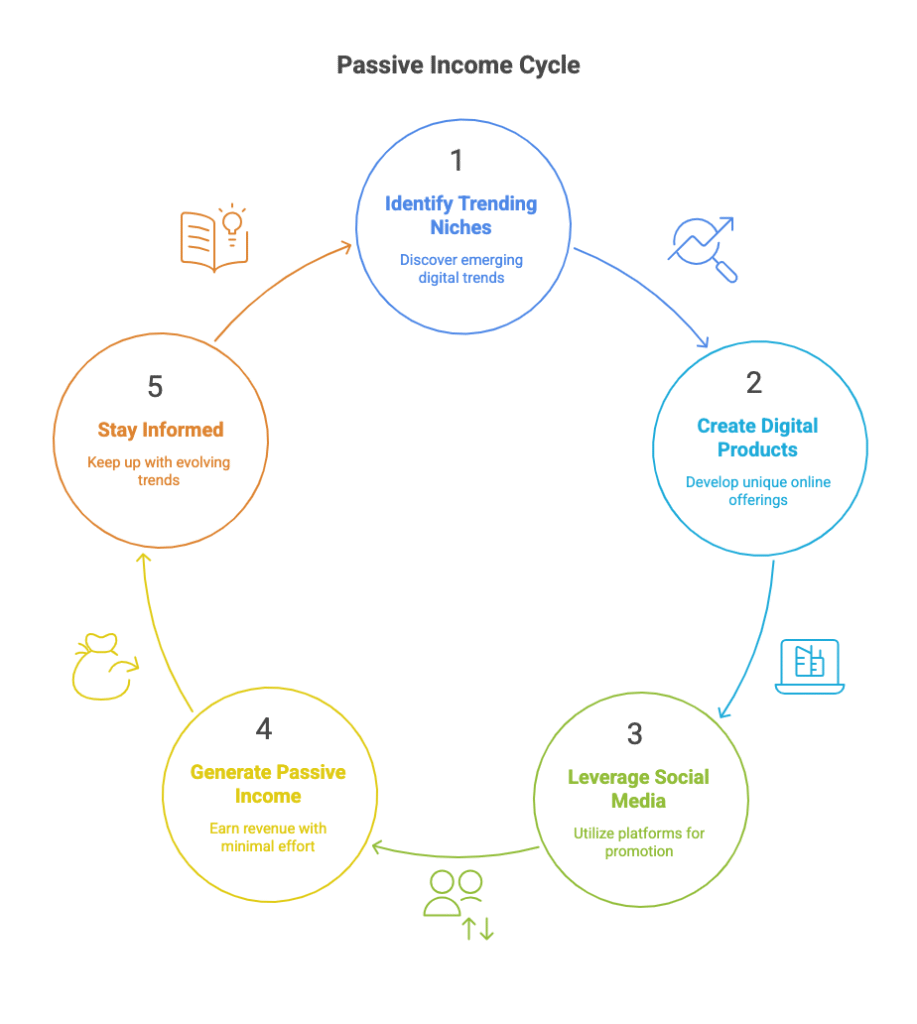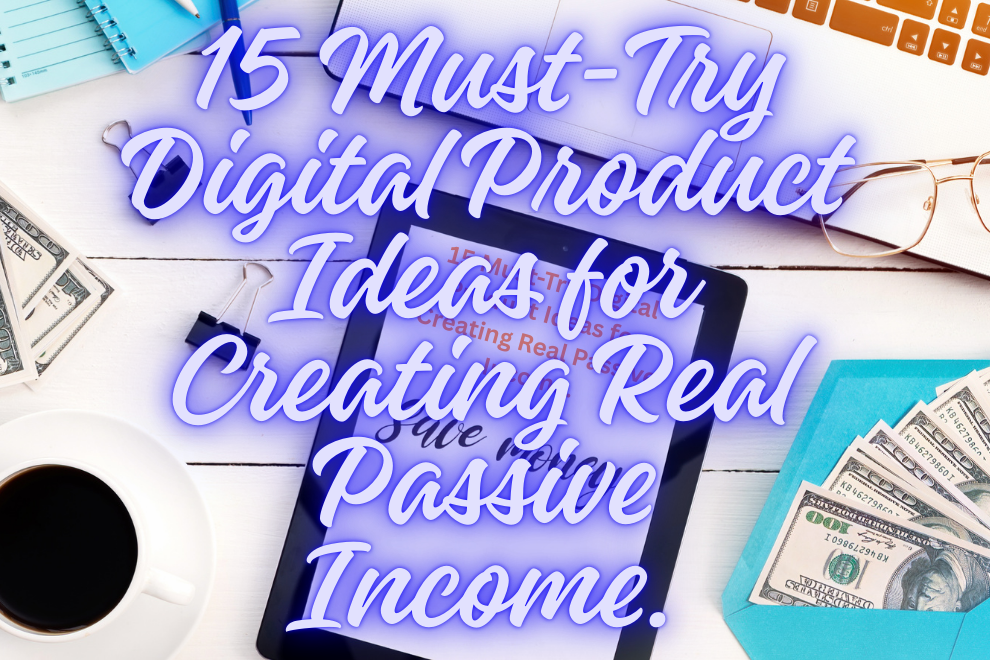Introduction your Blueprint to Digital Freedom
Do you experience the stress of working hourly? Your bank account doesn’t appear to reflect the 40, 50, or 60 hours you put in each week. What if you could create kinds of income that support you while you’re asleep?Everyone wants financial freedom, but not everyone has the time or resources to start a traditional business. That’s where passive income from digital products comes in.
The economy of the digital age is expanding. The worldwide e-learning market alone is predicted by Statista to reach $400 billion by 2030, and Etsy has seen a more than 50% annual growth in digital downloads such as templates and printable.
Introduce the Solution: This article is your practical guide. With 15 practical passive income ideas based on the fastest-growing digital categories of 2025, we’re breaking through the hype. These are real models with real promise, supported by statistics and case studies; they are not schemes to make quick money.
This article breaks down 15 practical passive income ideas in hot digital niches. Each one is realistic, backed by trends, and can be started with low investment. Let’s dive in.

Understanding Passive Income in the Digital Age.
To be clear, “passive” refers to “scalable effort.” Building an asset that provides recurrent revenue with little ongoing maintenance needs upfront work. Set realistic expectations: This is a marathon, not a sprint. The goal is building assets. Often requires just a laptop and an internet connection.Your audience is the entire world. Automation & Scalability: Digital products and services can be sold 24/7/365 without you being present. In reality, most people quit before they see results because they expect overnight success.
Solution: Think of passive income as front-loaded work. You create a digital product once, set up systems to sell it, and it continues earning with little ongoing effort.
Example: A designer creates a resume template and uploads it to Etsy. That single file sells hundreds of times, generating thousands in revenue with no extra work. That’s passive income in the digital age: scalable, automated, and digital-first.
Why Digital Niches Are the Future.
- Low startup costs – no warehouses, no shipping headaches.
- Global reach – anyone, anywhere can buy your product
- Evergreen demand – categories like education, health, finance, and creativity.
- Google Trends shows spikes in searches for “AI tools,” “printables,” and “digital planners” throughout 2024–2025. That means buyers are actively looking for these products right now.
Niche 1: The AI & Automation Revolution
Idea 1: AI-Powered Prompt Packs & Templates.
- Businesses and creators want to use AI tools like ChatGPT and Midjourney but struggle with ineffective prompts.
- The Solution: Create and sell curated packs of high-converting prompts for specific tasks (e.g., “100 SEO-Optimized Blog Post Prompts,” “50 Midjourney Prompts for Fantasy Book Covers”) ChatGPT prompts, or automation templates.
- How to Start: Use Gumroad or Ko-fi. Create a simple PDF or Notion doc.
- Reality Check: A creator on Gumroad reported making over $2,000 in a month selling a single “Advanced ChatGPT for Marketers” prompt pack.
- Canva templates, pitch decks, branding kits.
- Platforms: Etsy, Gumroad, Creative Market
- Passive model: design once, earn unlimited.
- Fact: “Canva template” is searched 30,000+ times/month on Etsy alone.
Idea 2: Build and Monetize a “No-Code” Tool
- Small businesses need custom software solutions (e.g., a booking system, a custom calculator) but can’t afford a developer.
- Use no-code platforms like Bubble.io or Softr to build a SaaS (Software-as-a-Service) tool. Charge a monthly subscription.
- How to Start: Identify a common problem in a community you understand. Build a Minimum Viable Product (MVP) and get feedback
- Reality Check: A study by NoCodeTech highlighted hundreds of solo founders earning $1k-$10k+/month with no-code SaaS products.
Niche 2: The 2.0 Creator Economy
Idea 3: Launch a Paid Newsletter on Beehiiv or Substack
Professionals are overwhelmed with free, low-quality information and crave curated, expert insights.
- The Solution: Become a trusted authority in a micro-niche (e.g., “Quantum Computing for Biologists,” “Sustainable Architecture Trends”). Offer deep dives for a monthly fee.
- How to Start: Grow a free audience first to build trust, then launch a paid tier.
- Reality Check: Substack’s own data shows its top 10 publishers earn a combined $20 million annually.
Idea 4: Create a Digital Template Empire
- The Problem: People want to start projects (e.g., a Notion life dashboard, a Canva social media kit) but hate starting from a blank page.
- The Solution: Design professional, customizable templates for popular tools (Notion, Canva, Excel, Google Sheets) and sell them on Etsy or your own website.
- How to Start: Solve your own problem first, then productize the solution.
- Reality Check: Etsy’s “Digital Products” category is booming, with top template shops generating six figures in revenue.
Niche 3: Digital Products & E-Learning
Idea 4: Develop and Sell an Online Course
- People want to acquire new, high-income skills (e.g., UX design, copywriting, data analysis) quickly and efficiently.
- The Solution: Package your knowledge into a structured video course. Use a platform like Teachable or Podia to host and sell it.
- The Solution: Package your knowledge into a structured video course. Use a platform like Teachable or Podia to host and sell it
- Reality Check: According to Thinkific, successful course creators on their platform can earn an average of $6,000 per course.
Idea 6: Publish an eBook on Amazon KDP.
- Readers in niche genres (e.g., low-content books, specific non-fiction how-to guides) are underserved by traditional publishing.
- The Solution: Write and publish a short eBook or create low-content books (journals, planners). Amazon handles printing and distribution (Print-on-Demand).
- How to Start: Use Kindle Direct Publishing (KDP). Research profitable keywords within the Amazon store.
- Reality Check: Author earnings reports consistently show that thousands of indie authors make a full-time living through KDP.
Niche 4: The Content & SEO Ecosystem
Idea 7: Build an Affiliate Blog
Shoppers read reviews before making online purchases.
- The Solution: Create a blog that provides genuine, helpful reviews and “best of” lists for products in a niche you love (e.g., “Best Home Gym Equipment Under $500”). Earn commissions for sales you refer via affiliate links (Amazon Associates, ShareASale).
- How to Start: Choose a niche with high-affiliate commissions. Focus on creating the best content, not just stuffing links.
- Reality Check: The website
thewirecutter.com(a review site) was acquired by The New York Times for over $30 million, demonstrating the value of trusted affiliate content.
Idea 8: Monetize a YouTube Channel with Ads.
- People prefer to learn via video. Google prioritizes video results in search.
- The Solution: Create evergreen, “How-To” or educational video content. Once you hit 1,000 subscribers and 4,000 watch hours, you can join the YouTube Partner Program and earn ad revenue.
- How to Start: Be consistent. One video per week is better than four videos in one month and then nothing.
- Reality Check: A niche channel with 50,000 subscribers can easily generate $1,000-$2,000 per month from ad revenue alone, not including sponsorships.
Niche 5: The Modern “Hands-Off” Business Model
Idea 9: Invest in Dividend Stocks or ETFs
- Inflation erodes the value of cash sitting in a savings account.
- The Solution: Use a platform like M1 Finance or Charles Schwab to automatically invest in a portfolio of dividend-paying stocks or ETFs. Earn quarterly payouts.
- How to Start: Start small with as little as $100. Focus on long-term, stable companies (e.g., ETFs like VYM or SCHD).
- Reality Check: The S&P 500 has historically returned an average of about 10% per year, including dividends. This is true ownership, not a side hustle.
Idea 10: Peer-to-Peer (P2P) Lending.
- Individuals and small businesses often need loans that big banks won’t provide.
- The Solution: Platforms like LendingClub and Prosper allow you to act as the bank. You fund small portions of many loans, diversifying risk, and earn interest.
- How to Start: Sign up for an account, transfer funds, and choose your risk tolerance (higher risk = higher potential return).
- Reality Check: Historical returns for P2P lending platforms have averaged between 4-7% annually, though defaults are a real risk that must be managed.
Niche 6: The Asset-Lite Revolution
Idea 11: License Your Photography or Music
- License Your Photography or Music Content creators need high-quality, royalty-free stock media for their projects.
- The Solution: Upload your photos, videos, or music tracks to marketplaces like Shutterstock, Adobe Stock, or Epidemic Sound. Earn a royalty every time someone downloads your work.
- Sell royalty-free music for YouTube, ads, games.
- Platforms: AudioJungle, Pond5.
- How to Start: You don’t need a fancy camera. Many smartphones shoot in 4K. Focus on niche, in-demand subjects.
- Reality Check: A contributor on Adobe Stock with a portfolio of 1,000 high-quality images can generate a few hundred dollars per month in consistent, passive royalties.
Idea 12: Design and Sell Print-on-Demand (POD) Products.
- People want unique, niche-specific apparel and merch that big box stores don’t sell.
- The Solution: Create designs for t-shirts, mugs, and posters. Use a service like Printful or Redbubble. They handle production, shipping, and customer service when a sale is made; you just collect the profit.
- How to Start: Integrate Printful with an Etsy store or build a simple Shopify site. Focus on micro-niche designs (e.g., “Plant Dad,” “Retro Engineering Diagrams”).
- Reality Check: While competitive, successful POD stores can generate significant revenue. A case study on
printful.comshowcases stores earning over $10,000 per month.
Niche 7: The Web3 & Digital Asset Space.
Idea 13: Staking Crypto Assets.
- Cryptocurrencies sitting in a wallet aren’t generating any return.
- The Solution: “Staking” is the process of actively participating in transaction validation on a proof-of-stake blockchain. By locking up your crypto, you help secure the network and earn rewards.
- How to Start: Use established exchanges like Coinbase or Kraken, which offer simplified staking for major coins like Ethereum (ETH).
- Reality Check: Staking rewards vary but can range from 3-10% APY. Crucial Warning: This involves significant risk due to crypto’s volatility. Only use money you can afford to lose.
Idea 14: Rent Out Your Digital Assets.
- The virtual world needs virtual space. Discord servers, online communities, and even game servers need hosting.
- The Solution: If you have a powerful PC or server, you can rent out computing power, storage, or even a pre-configured game server (e.g., for Minecraft or ARK).
- How to Start: Use platforms like vast.ai (for GPU power) or create listings on community marketplaces.
- Reality Check: This is a more technical idea, but a powerful GPU can earn $50-$100+/month when rented out consistently to users training AI models.
Idea 15: Create a Paid Community or Membership Site
- Online forums are often filled with noise and low-value content. People crave a focused, private space for networking and learning.
- The Solution: Use Circle.so or Discord to create a gated community around a shared interest. Charge a monthly membership for access to exclusive content, networking, and live events.
- How to Start: Build an audience first (e.g., on Twitter, LinkedIn, or a free Discord). Then, offer a premium tier.
- Reality Check: A community with just 100 members paying $20/month generates $2,000 in MRR (Monthly Recurring Revenue)—a fantastic, predictable income stream.
Your First Step: How to Choose Your Idea.
The 3-Filter System for Choosing Your Path.
- Skills & Knowledge: What do you already know or love learning about?
- Time & Capital: How much upfront time can you invest? What’s your startup budget?
- Scalability Potential: Which idea has the clearest path to scaling beyond your own time?
- Check demand (Google Trends, SEMrush).
- Ensure profit margins (low cost, high scalability).
- Start small → test → scale.
- The #1 Rule: Start Before You Feel Ready
- Imperfect action beats perfect inaction every time. Your first digital product or website won’t be perfect, and that’s okay. Launch, get feedback, and iterate.
How to Increase Passive Income from Digital Goods
- Research trending niches.
- Create one product.
- Set up a sales funnel (landing page + email list).
- Promote via SEO + social media.
- Automate with tools (Zapier, Mailchimp).
Conclusion:
We reviewed 15 successful passive income strategies in popular online markets. These possibilities, which range from SaaS solutions to AI prompt packs, are genuine and expandable.True financial resilience doesn’t come from one job; it comes from building a “lattice” of multiple, diverse income streams.
- These 15 ideas are the blueprints
- You have the tools and the knowledge.
- The digital economy is waiting.
- Pick one idea that resonates with you and commit to taking the first step this week.
FAQ.
Is passive income truly passive?
Think of it as “front-loaded effort.” Most ideas require significant work to create, set up, and market initially. The “passive” part kicks in once the system is built and can generate revenue with minimal daily maintenance. It’s about building assets that work for you.
How much money can I realistically make?
Earnings vary wildly based on the niche, your effort, and market demand. Realistic early goals are an extra $100-$500 per month. Some ideas, like niche websites or successful SaaS tools, can scale to five or six figures annually, but this is not the norm and requires consistent, smart work.
Do I need a lot of money to get started?
Absolutely not. This is the beauty of digital niches. Many ideas on this list (like affiliate blogging, digital templates, or print-on-demand) can be started for less than $100 (covering website hosting, domains, and initial software subscriptions). The primary investment is your time and skill.
What is the best passive income idea for a complete beginner?
For a true beginner, selling digital products (like Canva templates or Notion planners) or starting an affiliate blog are excellent choices. They have a low financial barrier to entry, and the skills required (basic design and writing) are easy to learn and practice.
How long does it take to see my first income?
This is the hardest part. You must be patient. Most digital assets take 3 to 6 months of consistent work before generating meaningful revenue. Search engines need time to index your content, and you need time to build an audience. This is a long-term strategy.
Can I do this alongside my full-time job?
Yes! In fact, that’s the recommended path. Building passive income streams is best done as a side project. This eliminates financial pressure and allows you to grow your digital assets sustainably without risking your primary income.
What’s the biggest mistake beginners make?
The #1 mistake is giving up too soon. They expect results in weeks, get discouraged, and quit right before they might have broken through. The second biggest mistake is trying to do everything at once. Focus on mastering ONE idea before adding another.
Are there any risks involved?
Yes. The main risks are:
Time Investment: You might spend time on an idea that doesn’t yield a return.
Market Risk: Your chosen niche might not be profitable.
Financial Risk: If you invest in courses, software, or advertising without a plan, you can lose money.
Mitigate this by starting small, validating your ideas early, and never investing more than you can afford to lose.
Passive Income Ideas To Boost Your Earnings (Upwork)
Resources & Tools for Entrepreneurs — Smart Passive Income
Resources Passive Income for Developers — AzamSharp

